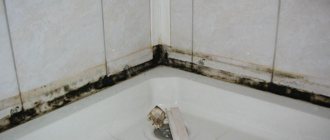What to do if the toilet tank is sweating? There are several ways to eliminate the phenomenon: reduce the temperature in the bathroom, check the ventilation - it should work properly, the float mechanism and shut-off valves may break - replace.
The question of how to get rid of condensation on a toilet tank arises quite often. First of all, it is important to understand what this phenomenon is and what it may mean in the future.
Then you need to understand what caused the water droplets to appear. In most cases, the cause is a breakdown of components or insufficient ventilation of the bathroom, resulting in increased levels of moisture.
It is not always necessary to take serious measures to eliminate condensation. In some cases, it is sufficient to make minor changes to reduce the volume of condensed liquid.
What is condensate
In general, condensate is a water deposit that arises from the air and settles on various surfaces. As a rule, it appears due to a sharp change in temperature.
Often a similar phenomenon can be observed after taking a shower on the walls of the stall and other objects, but such moisture evaporates within a few minutes. But if thin streams of water constantly form on the toilet tank or pipes, this is a problem and certain measures must be taken to eliminate it.
Note! Condensation on the toilet tank is formed due to the influence of cold water (temperature 8-16 degrees) on the surface of the tank from the inside, as well as the influence of warm air flow (temperature 26-30 degrees) on the outer wall. Due to the large temperature difference, humidity increases and sediment appears.
Forced ventilation
In the case when all the necessary actions with the tank have been carried out, and the presence of moisture on it can still be traced, it is worth considering forced ventilation of the room. Ventilation problems can be solved in the following ways:
- Forced ventilation is one of the effective methods, which is suitable even when moisture collects not only on the tank itself, but also on all surfaces of the bathroom. This solution to the problem consists of purchasing a special fan, which is installed in the circulation hole.
To supplement air circulation, you can install grilles on interior doors. This will allow the humid air to mix faster with the rest. It is better to entrust installation work to professionals who will correctly calculate the required (specifically for a given room) ventilation level. Before starting work, you need to make sure that the ventilation ducts are clean and have good draft.
There are often situations when the previous residents of an apartment cover the ventilation hole with some kind of material, and the new guests simply do not pay attention to this.
- If condensation appears slightly, you can simply leave the doors to the bathroom ajar, or make a strip of space in their lower part so that they do not fit tightly into the door frame.
- An air dehumidifier also helps in the fight against condensation. This is an electrical device in which a fan is built in. Thanks to it, streams of moist air penetrate into the cooling chamber, where the liquid is separated and collected in a container, and the already dried air is returned to the room.
Why does condensation appear on the tank?
There are several basic conditions that need to be checked to determine why condensation is forming on the toilet tank:
- frequent use of plumbing equipment, as a result of which the water in the drain tank does not have time to heat up to the room temperature. If there are a large number of residents, the toilet is used at short intervals, which contributes to the constant appearance of condensation;
- a malfunction of the drain, due to which the heated water is drained, and the deficiency is replenished with cold liquid from the water supply. Malfunctions of the shut-off valve or other fittings are a fairly common cause of condensation on the toilet tank;
- high humidity in the bathroom. For example, clothes are sometimes dried in the bathroom, as a result of which the air is filled with moisture, but it cannot evaporate from plastic and earthenware surfaces, so water deposits form on them;
- lack of sufficient ventilation of the room. In some cases, home owners decide to completely close the ventilation window during construction and renovation. However, this disrupts the circulation of air flow and increases humidity, so strong condensation appears on the toilet tank;
- location of various heating appliances or hot water pipelines next to plumbing.
Preventive measures
After cleaning, it is recommended to wipe all surfaces dry.
To avoid condensation, you should follow some rules.
- Check ventilation operation . If the traction weakens or disappears, the channels are urgently cleaned. If the blockage occurs deep in the mine, a specialist is invited.
- Ventilate the room , especially if it is a combined bathroom.
- Utilities and toilets are regularly inspected for leaks . As soon as a leak appears, repairs begin immediately.
- Do not dry clothes in a shared bathroom where there is no forced ventilation. Natural circulation cannot cope with such a load.
- During cleaning, after washing, the floor and walls are thoroughly dried. If the bathroom is shared, be sure to wipe the bathtub dry after showering or bathing.
You should not leave open containers with water, as well as wet towels, washcloths, and rags in the bathroom.
What are the dangers of condensation accumulation?
How urgently it is necessary to solve the problem and whether it needs to be solved at all, each apartment owner decides independently. In some cases, fogging of the drain container is not a constant phenomenon, i.e. the condensation has time to dry.
In such a situation, you don’t have to worry, because... this will not lead to any serious negative consequences. However, if you have a constantly wet tank, you need to think about how to get rid of the sediment. Dripping streams form puddles on the floor that need to be cleaned up regularly. Such a problem can cause significant inconvenience to the apartment owner.
Possible consequences if you do not get rid of heavy condensation on the tank in a timely manner:
- sediment will get into thin cracks and areas where it is difficult to reach, then an unpleasant smell of stagnant water will appear;
- The humidity level in the room will increase, which will make it an excellent environment for the proliferation of various fungal bacteria and the appearance of mold. Such bacteria will not only spoil the appearance of walls and other surfaces, but will also be capable of causing allergy attacks in residents, frequent headaches and other health problems;
- after several years of constant moisture, if there is no struggle to eliminate the cause of its appearance, the tank will begin to collapse. On the outside, small cracks will appear on the surface, in which fungal and mold bacteria will multiply;
- high humidity will lead to rotting of various objects made of wood. For example, wooden flooring.
- pipelines, furniture and other objects made of metal will undergo corrosive processes. Mold can also grow on the inside of the mirror, making it unusable.
Therefore, if condensation is dripping from your toilet tank, it is recommended that you immediately take appropriate measures to get rid of it. Otherwise, this can lead to the destruction of furniture, interior items, and the proliferation of dangerous fungi and mold.
If you do not get rid of the problem in a timely manner, after 5 years you will need a major restoration of the toilet.
Types of locking mechanisms and methods for replacing them
If the drain fittings are to blame for the condensation dripping from the tank, then it must be replaced. First you need to figure out what type of mechanism is installed. Shut-off valves are:
- Rod or exhaust. The oldest and most common type, but also the most reliable. The flush is triggered after the rod rises, opening a hole for draining water.
- Push-button. This is a modern system designed to save water consumption. Allows you to press a button to regulate the amount of water drained.
- In the form of a mechanism with a pneumatic drive.
After determining the type of fittings, it must be replaced:
[smartcontrol_youtube_shortcode key=”replacing toilet fittings” cnt=”4" col=”2" shls=”true”]
- Carefully remove the old fittings and clean all joints from limescale.
- Install the seal in the appropriate place in the tank.
- Place the fittings in the drain container and secure with the nut included in the kit.
- Screw on the remaining fasteners, first placing gaskets on the bolts.
- Install the tank in the designated place.
- Install the upper part of the fittings and connect to the water supply point.
- Close the container with a lid, connect the drain mechanism and check operation.
USEFUL INFORMATION: Features of the construction of a Russian bath
How to get rid of the problem
After detecting sediment, it is recommended to study information on how to get rid of it. There are several ways to fix the problem, depending on why condensation collects on the toilet tank in a particular case.
Change of microclimate
If the cause of the increase in moisture is a ventilation malfunction, you will need to get rid of disturbances in the microclimate of the room, in particular, the use of specialized devices.
Let's determine what needs to be done if condensation on the toilet cistern occurs due to problems with the microclimate:
- take care of forced ventilation of the room. If there is a small gap under the door, air will flow through it. If it is missing, it is recommended to check the operation of the ventilation duct (this can be easily done with a match or lighter). If there is no sufficient draft, it is necessary to clean the ventilation shaft. If this does not help, you will need to install an exhaust ventilation device. When choosing such a device, it is advisable to focus on the type of toilet. If it is combined, then you should opt for a fan model with improved protection against moisture and water splashes;
- install an air dryer. This device will collect water molecules in the air and localize them in a separate container. The device operates based on the readings of the built-in hygrometer. When choosing, you should consider the size of the bathroom.
Such actions in most cases lead to the prevention of a situation where condensation accumulates on the toilet tank.
Increase in water temperature
As mentioned above, sediment is formed due to a temperature difference of approximately 15 degrees between the water in the tank and the temperature in the room.
Therefore, in order to get rid of sediment, it is necessary to minimize the difference by increasing the temperature of the working fluid in the container. Let's determine what needs to be done if condensation collects on the toilet cistern due to this reason:
- insulate the pipeline (this will increase the temperature in the pipes by several degrees). Ready-made material for this is sold in many construction stores;
- connect the hot water supply to the tank instead of the cold water supply. However, it is advisable to do this only in the absence of an appropriate meter, otherwise the costs of water consumption will be very high;
- install a boiler system;
- create a heat exchanger using a thermal apartment riser;
- install a half-flush system, which will ensure dilution of already heated water with cold water.
Tank modernization
If the bathroom ventilation functions normally and has sufficient draft, and the problem is not a violation of the microclimate, a different approach is used to get rid of sediment.
How to deal with condensation on a toilet cistern:
- insulation of the tank from the inside;
- placement inside a special plastic tank. The distance between the inserted plastic container and the tank should be 2-3 mm. Gaskets made of silicone or rubber are installed in a small gap.
- dismantling the toilet and installing a more modern model, the tank of which is protected against condensation. Such models have a double tank with a plastic and earthenware container. This option is the most expensive, but cost is the only drawback of such toilets.
The internal insulation of the container is carried out using polystyrene foam, tepofol, foamed polyethylene and other heat-insulating materials. It is important to completely turn off the water and completely remove any remaining liquid from the tank before starting the procedure. The procedure may also require glue and a sealant.
When choosing a material, it is recommended to purchase a layer with a thickness of up to 1 cm so that the working volume of the tank does not decrease. After gluing the insulation, it is necessary to treat the joints with sealant. Once it has hardened, you can cut holes to install plumbing fixtures.
In some cases, polyurethane foam is used for insulation. It has excellent thermal insulation properties, but involves a more complex process. It is advisable to apply the foam in 4 stages to ensure uniformity.
Then you will need to wait some time until it hardens completely, after which you can cut off the excess part. For high-quality insulation, a layer one centimeter thick is sufficient.
Watch the video
An easy way to eliminate condensation (100% works)
Repair of drain structure
If the toilet tank is constantly leaking, then the water in the tank does not have time to heat up, resulting in the formation of condensation on the surface.
If the shut-off valve is broken, the rubber bulb has lost its elasticity, or the rubber seal has stopped performing its functions, water from the tank will constantly drain into the sewer - see common causes and ways to eliminate them. This situation can lead to up to 2-3 liters of condensation per day.
The answer to the question of how to deal with condensation on the toilet tank in this case is to replace non-functioning parts. As a rule, broken components cannot be repaired, so it is better to purchase new ones.
ADVICE! When choosing, it is important to focus on the model of the toilet or cistern, because otherwise, the purchased parts may not fit correctly and the problem will persist.
When installing a new drainage system, it is advisable to adhere to some rules:
- get rid of lime deposits in the holes;
- change the seal (rubber gasket);
- It is better to tighten plastic nuts by hand, but not very tightly. The use of metal tools and tight fastening may lead to breakage of fasteners. A wrench should only be used when there are metal bolts in older models;
- The drain structure should not touch the walls of the tank.
Reducing drain volume
If a large family uses plumbing, the water will be flushed frequently, which will lead to the fact that the collected liquid will not have time to heat up. In this case, reducing the volume of drained water will help get rid of condensation.
How to eliminate condensation on a toilet tank:
- install a half flush button. You can do this yourself by adjusting the shut-off valve mechanism, or install a new tank;
- install a double “start/stop” button, which will allow you to control the volume of liquid discharged.
If this is not possible, it is advisable to purchase an upgraded tank with a button that helps minimize drainage.
The question of how to remove condensation from a toilet tank often worries apartment owners. If sediment formation occurs rarely and the moisture has time to dry, radical measures will not be required.
However, in other cases, it is important to take timely care of how to get rid of condensation. There are several options for solving the problem, the appropriate one is selected based on what caused the problem.
Checking the central exhaust system
If, after replacing the fittings, the question “how to remove condensation on the toilet cistern” remains relevant, then it is necessary to eliminate moisture from neighboring rooms and check the ventilation. What to do in this case:
- Call representatives of the management company and have them check the entire ventilation system and, if necessary, decide on cleaning it.
- In typical apartments, there is a ventilation hole between the bathroom and the toilet, and the second, exhaust, is located in the wall of the toilet. It is necessary to measure the distance between these holes, buy a pipe for the hood and install it.
With a properly installed exhaust system, the humidity in the toilet will be normalized and condensation will no longer appear.
Factors in the formation of moisture droplets
Condensation forms on surfaces that are exposed to temperature changes. The situation with the flush cistern in the toilet is exactly this: fairly cold water flows into it, but the air in the room itself is warm. The walls quickly cool, which leads to the appearance of moisture outside.
Factors contributing to large temperature differences are:
The minimum temperature difference that can lead to condensation is 15 degrees.
Does it need to be removed? What are the consequences of a new appearance?
Any moisture must be dealt with. When it comes to condensation on the tank, experts highlight the following consequences:
- the accumulation of sediment in small cracks can lead to chips on the toilet enamel;
- due to constant stagnation of water, mold occurs, which negatively affects the respiratory system of household members;
- unwanted bacteria appear;
- metal elements begin to be destroyed by corrosion.
If you do not immediately begin to deal with excess moisture, then in a few years you will have to carry out a major restoration of the entire bathroom. For the average citizen, such expenses can have a negative impact on well-being.
Normalization of air circulation
First of all, check how effectively natural ventilation works. Ventilation windows should be covered with bars and under no circumstances clogged with dirt and dust.
Natural ventilation is the key to protection against high humidity and mold
Many users prefer to leave the bathroom door open, but a better option is to make a gap at the bottom.
To improve air circulation, you should install a ventilation grill in the bathroom door
Before installing decorative mesh, the channel should be cleared of debris; if this has not been done, then there is a possibility that there is no draft in the system. In this case, it needs to be cleaned. In a private house, this responsibility falls directly on the owner, in multi-storey residential buildings - on the housing office, where you should contact.
Natural ventilation is not always ensured by ventilation. In this case, an artificial one should be installed. It is difficult to do this on your own, since you need to take into account the power of the equipment and the state of the microclimate of the room, so we recommend contacting special centers.
If natural ventilation is of poor quality, it is necessary to organize forced ventilation
There are also systems that dry air, which are aimed at shared bathrooms. They provide a reduction in humidity by recycling water vapor.











